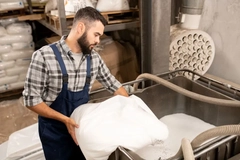Banana peel packaging? Food chemists explore circular bioeconomy solution
21 Feb 2024 --- The Department of Dairy and Food Science at South Dakota State University (SDSU), US, has published a research project, led by associate professor Srinivas Janaswamy, showcasing how banana peels could offer a replacement for petroleum-based plastic in the packaging industry.
The study, titled “Biodegradable packaging films from banana peel fiber,” published in Sustainable Chemistry and Pharmacy, demonstrates how banana peels can be transformed into robust, transparent and biodegradable packaging materials.
“Many of us consume at least one banana daily,” Janaswamy says. “After enjoying the delicious fruit, we discard the peel. What if we could find a use for the peel that helps eliminate plastic waste?”
“Every year, almost 36 million tons of banana peels are produced, most of which are disposed of as waste. The food processing industry discards a huge amount of banana peel in landfills while manufacturing chips, flour, juice, jam, baby food and other banana products.”
“Finding a more practical use for banana peels is important for providing financial benefits to the agricultural industry and preventing environmental pollution.”
 The films developed from banana peels could be used for sack bags and related packaging applications.Upcycling banana peel
The films developed from banana peels could be used for sack bags and related packaging applications.Upcycling banana peel
The process developed by Janaswamy and Mominul Hoque, a graduate research assistant at SDSU, begins by converting banana peels into a pulp-like substance and extracting lignocellulosic material using a chemical treatment method. The resulting fibers undergo refining processes before being fashioned into films.
“My goal was to replace single-use plastic bags. In this regard, we are extracting cellulosic residue from various agricultural biomass, fruits, and vegetables and testing the feasibility of producing biodegradable films. As of today, we focused only on film characterization,” Janaswamy tells Packaging Insights.
These films exhibit strength, transparency and biodegradability within 30 days at 21% soil moisture content.
“Our research involving green and recyclable chemicals is a promising economical and sustainable route to produce biodegradable films to replace petrochemical plastics and an attractive contribution to the circular bioeconomy,” says Janaswamy.
“The films of the banana peel fibers display tensile strength of more than 30 MPa, which would be attractive for sack bags and related packaging applications.”
The US Department of Agriculture National Institute of Food and Agriculture funded the project.
For the past few years, Janaswamy has been researching how different agricultural byproducts, like banana and spent coffee grounds, can be utilized to create biodegradable films. Further research aims to enhance the flexibility of the films and explore avenues for large-scale production.
By Radhika Sikaria











